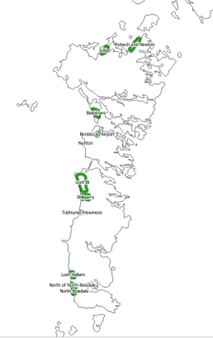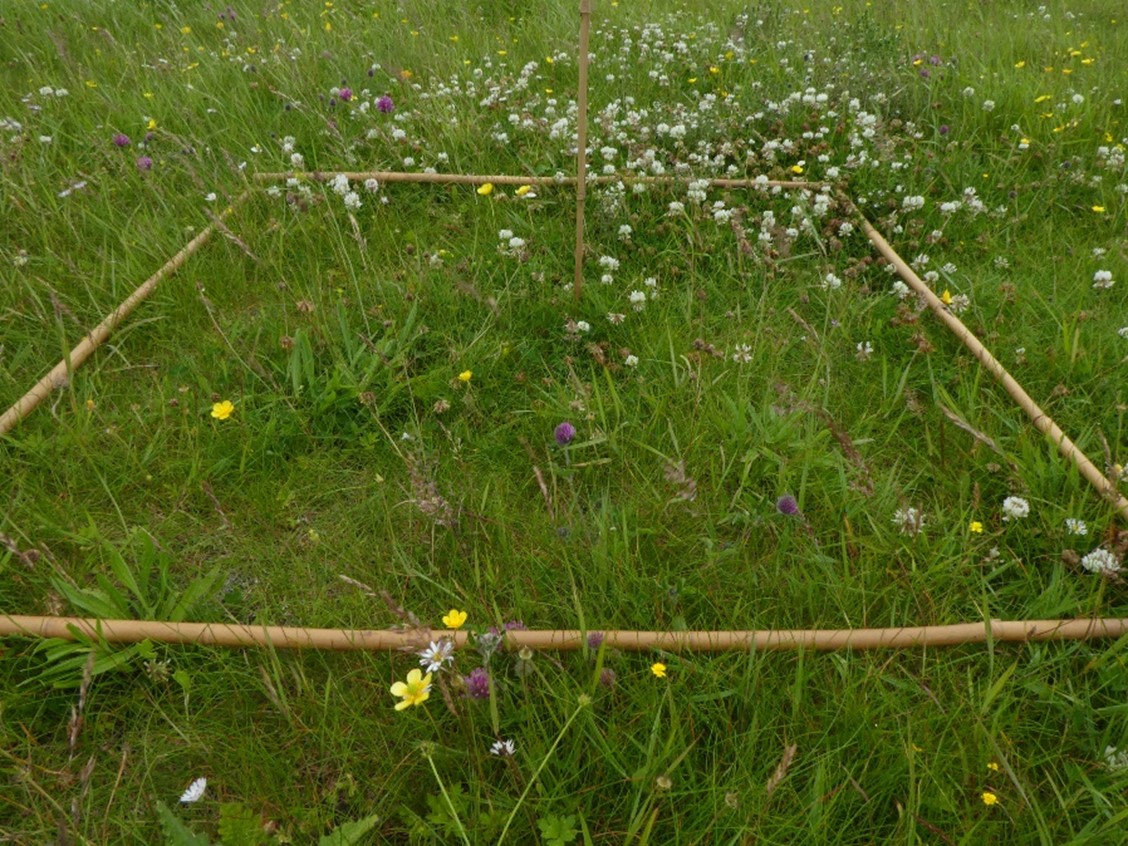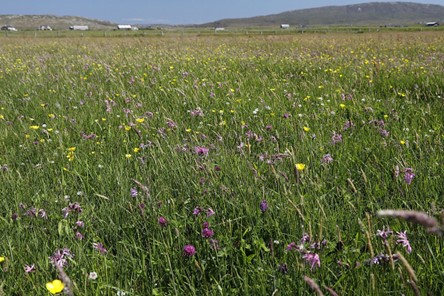2021 saw a continuation of our work in the Western Islands of Scotland, primarily funded by the Halpin Trust. We sent botanists and other field workers back to the Outer Hebrides last July to develop two aspects of the project.
We had previously gathered data from the wet grasslands that form the landward end of the machair system in the Western Isles of Scotland. These grasslands seemed to be very similar to wet floodplain meadows in England and Wales. We wanted to explore whether the hydrological drivers that help shape these grassland communities are similar to those we have studied in England, and whether these grasslands are different enough to those elsewhere that they could be considered unique to the Western fringes of Europe
In 2021 therefore, we established two more research sites, to sit alongside the field in which we installed dipwells and recorded quadrats in, in 2019 (Figure 1). We also re-visited our first site to re-record the quadrats and to download the automatic loggers.
In addition, we arranged interviews with the crofters who manage these species-rich grasslands to understand how site management works, and their concerns and aspirations for the future. This work was carried out by Edinburgh University’s Dr Ann Bruce, who is running a related project on the role of livestock in providing resilient food systems in remote, upland regions http://upland-resilience.org/.
We have continued to analyse the botanical data from these sites and from similar ones elsewhere, to understand whether the plant communities we provisionally identified in 2019 are genuinely new, and if so, how widespread they are.
 Figure 1. Areas targeted on the Outer Hebrides in 2021 for botanical survey, crofter interviews and new research sites.
Figure 1. Areas targeted on the Outer Hebrides in 2021 for botanical survey, crofter interviews and new research sites.
What we have found so far
Conservation status of wet grassland communities in Scotland
The surveys undertaken by the FMP between 2018 and 2021, and the use of other historic data where available, have enabled us to identify new plant communities not found elsewhere in England and Wales. It is likely that these plant communities are local to the western edges of Europe and therefore rare internationally.
In order to confirm this however, the next stage of the work is to compare these data to similar data gathered from the Irish Republic and Northern Ireland. We hope to be able to do this in late 2022.
Table 1. A list of the new, provisional plant communities
| Latin name |
Common name |
Code |
| Caltha palustris - Carex nigra grassland |
Marsh marigold - Common sedge grassland |
CaCn |
| Agrostis stolonifera-Bellis perennis grassland |
Creeping bent - Daisy grassland |
AgBp |
| Agrostis stolonifera-Carex flacca grassland |
Creeping bent - Glaucous sedge Fen |
AgCf |
| Carex nigra - Potentilla erecta - Rhytidiadelphus squarrosus grassland |
Common sedge - Tormentil - Springy Turf - moss grassland |
Fen |
| Carex nigra - Agrostis stolonifera - Senecio aquaticus grassland Potentilla anserina variant |
Common sedge - Creeping bent - Marsh ragwort community; Silverweed variant |
MG14N |
The plant communities listed above have been mapped as covering over 60 ha following our surveys, compared to just over 100 ha of equivalent vegetation recorded in England and Wales. The Scottish resource therefore has UK-wide significance. The plant communities identified are specifically located along the west coast of Scotland. We plan to explore data from corresponding areas along the West Coast of Ireland, and possibly explore other western fringes of Europe, including Norway.
Summary of crofting interviews
All crofters expressed a deep and detailed knowledge of their land, how it has changed over decades, and they had a good knowledge of the birdlife on the croft. The area is important for a number of ground-nesting bird species, there are a number of environmental schemes for managing these bird populations, and the RSPB has a strong presence on the islands. A number of the crofters indicated they would be interested in understanding more about the characteristics of the plants on their crofts, both in terms of their impact on the grazing animals and their value in terms of biodiversity. However, while crofters were aware of the plant life on their crofts, they tended to have limited understanding of its value.
The three main threats to continuing environmentally-sensitive management of the Machair in North and South Uist would appear to be land abandonment, changes in subsidy regime and sea level rise.
Maintaining drains was seen as an important agricultural activity, but one that relied on group activity and therefore was declining in some areas. The ageing population of crofters, together with the difficulty for new entrants to crofting, poses the possibility of land abandonment in the future. However, the Scottish Crofters Federation suggests there is considerable unmet need for people wishing to access crofts. The crofters rely on subsidy payments to continue their management, and changes in subsidies may promote or discourage various options. Climate change, through the effect of sea level rise was identified by crofters as a future challenge.
Management
The species-rich wet meadows recorded in this survey are the result of decades, if not centuries, of grassland management by the local crofting community. The taking of a hay crop in July/August followed by grazing of the aftermath through autumn, plus the maintenance of a network of field gutters and ditches to remove excess water after heavy rain, has resulted in a diverse community of plants supporting a range of other taxa and creating a visual spectacle in summer. This management system is important for the maintenance of the wildflower communities. It is also important that the wider hydrological system (involving groundwater seepage from the sand dunes) is not interrupted by development, or other activities.
 Creeping bent - Glaucous sedge (Agrostis stolonifera - Carex flacca) grassland
Creeping bent - Glaucous sedge (Agrostis stolonifera - Carex flacca) grassland
 Creeping bent - Daisy (Agrostis stolonifera – Bellis perennis) plant community
Creeping bent - Daisy (Agrostis stolonifera – Bellis perennis) plant community
 Marsh marigold - Common sedge (Caltha palustris-Carex nigra) grassland
Marsh marigold - Common sedge (Caltha palustris-Carex nigra) grassland
Subscribe to make sure you don't miss out.